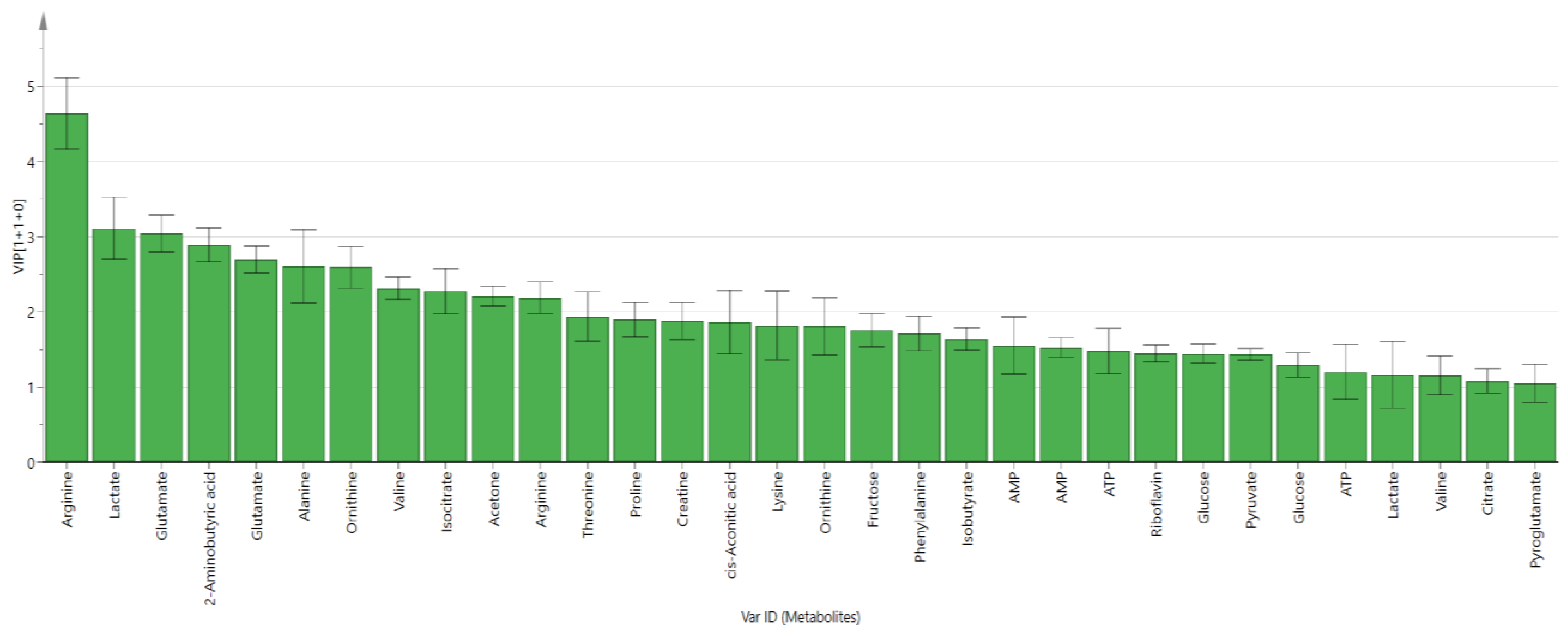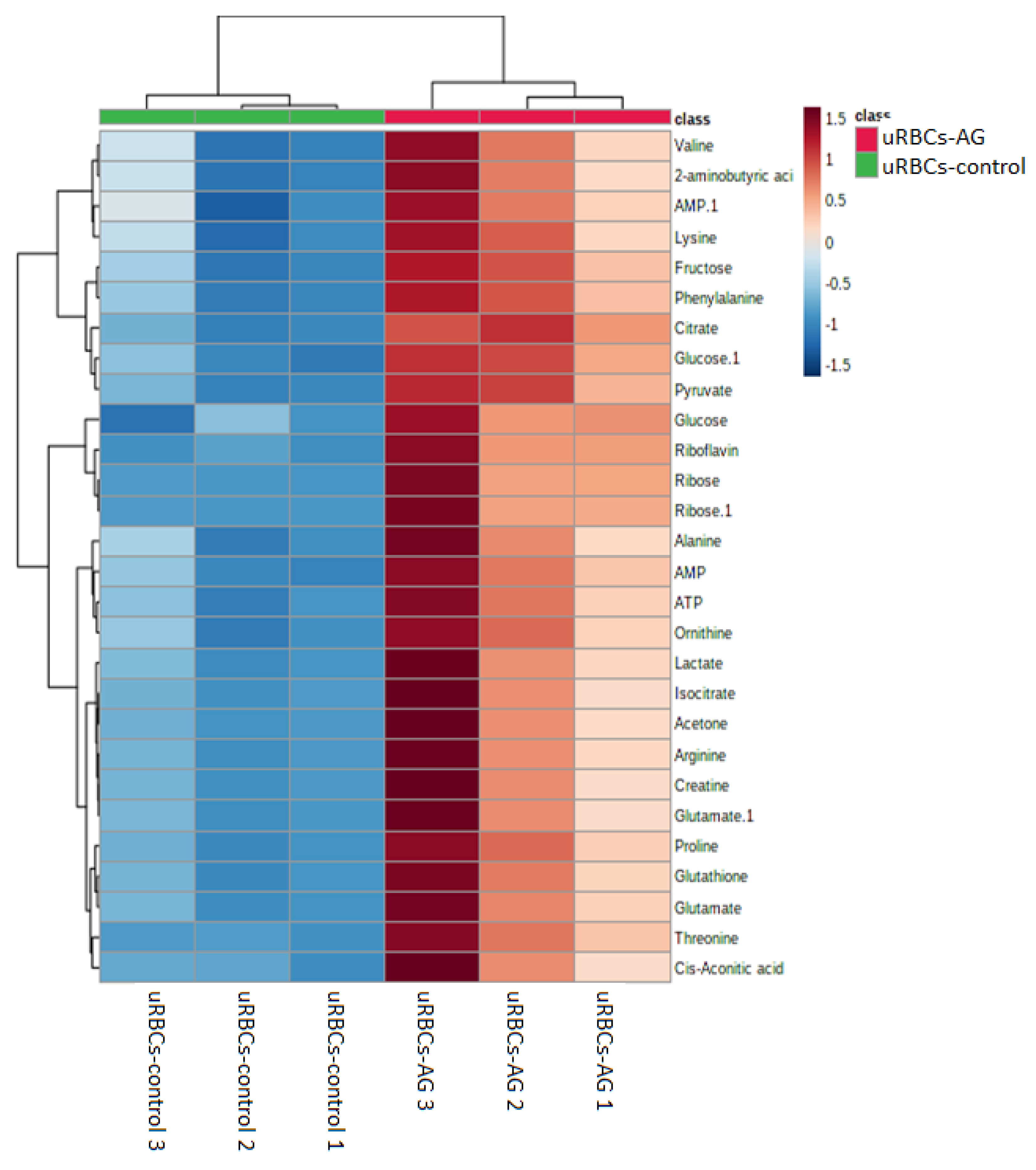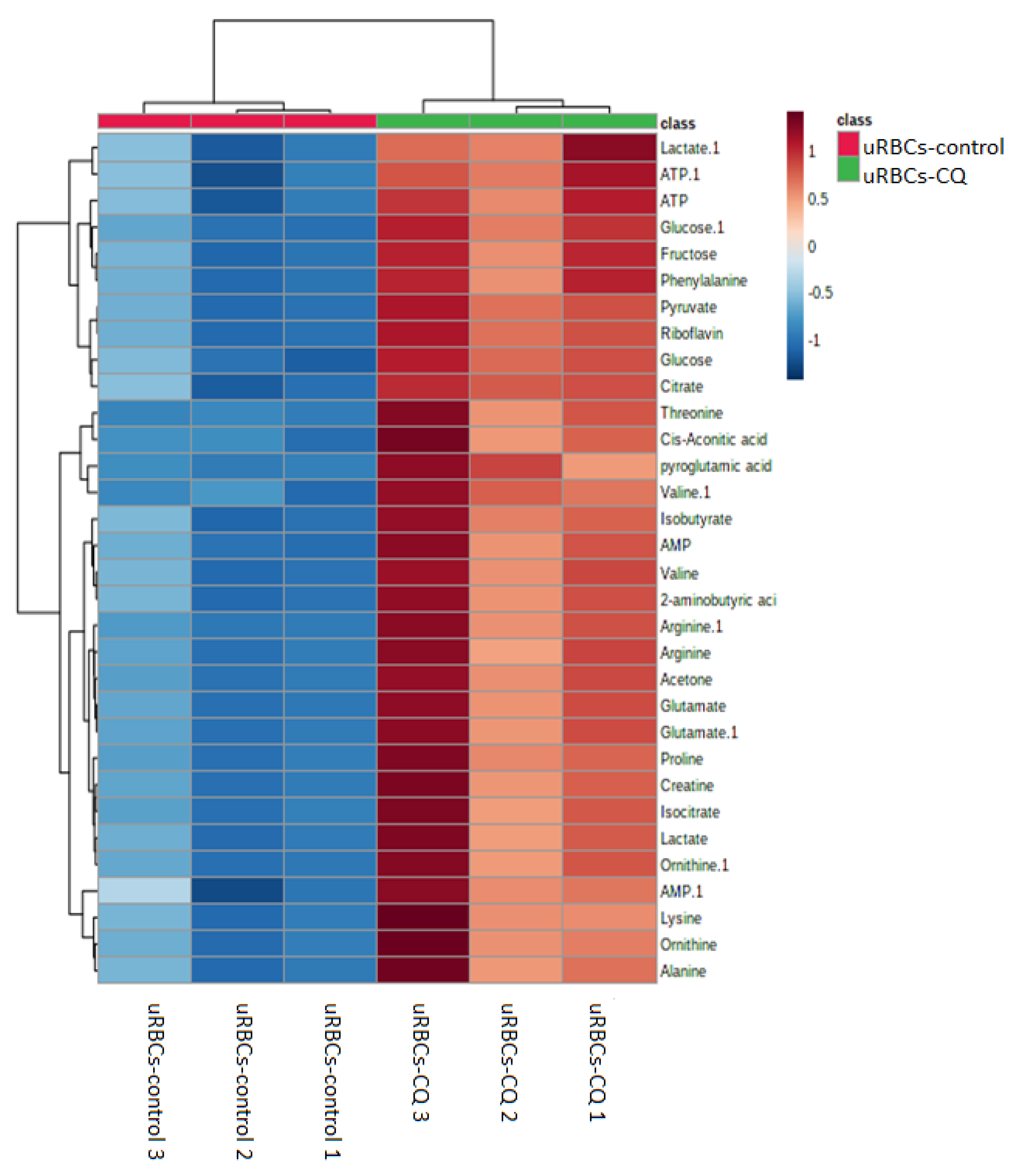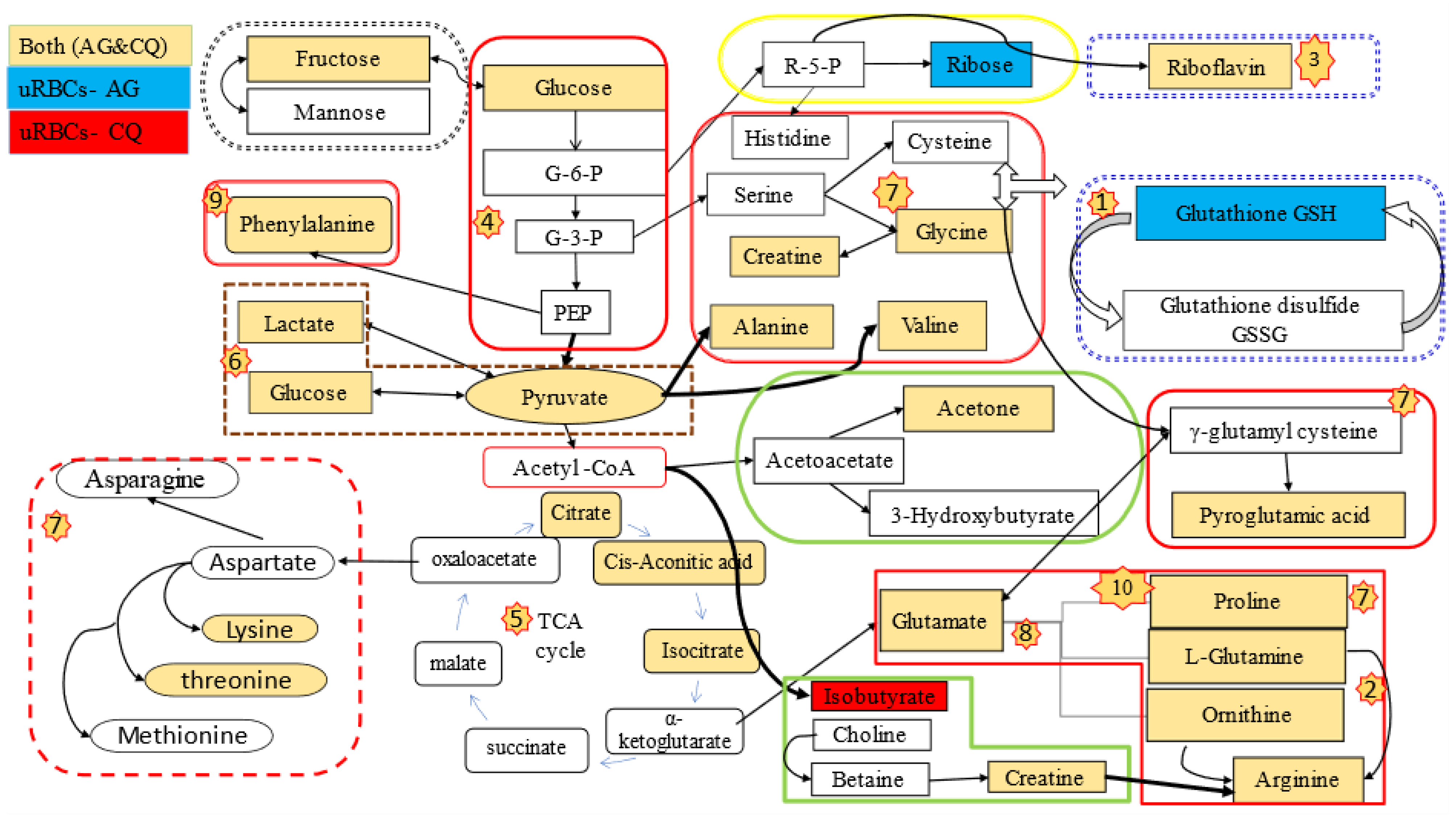Investigation of Andrographolide Effect on Non-Infected Red Blood Cells Using the 1H-NMR-Based Metabolomics Approach
Abstract
:1. Introduction
2. Results and Discussion
2.1. 1H-NMR Spectra of Uninfected RBC Extracts
2.2. Principal Component Analysis (PCA) of 1H-NMR Data
2.3. Biomarker Identification by OPLS-DA
2.4. The Model Validation of the OPLS-DA
2.5. The Hierarchical Cluster Analysis (HCA)
2.6. Analysis of the Perturbed Metabolic Pathways by AG and CQ in Uninfected RBCs
2.6.1. Amino Acid Metabolism
2.6.2. Glutathione Metabolism
2.6.3. Carbohydrate Metabolism
3. Materials and Methods
3.1. Chemicals and Consumables
3.2. Blood Collection and Preparation for Culture
3.3. In-Vitro Cell Culture of Uninfected RBCs
3.4. The Extraction of Metabolites of Uninfected RBC
3.5. H-NMR Spectroscopy Analysis
3.6. Processing Data of 1H-NMR Spectra and Metabolite Identification
3.7. Statistical Analysis
4. Conclusions
Supplementary Materials
Author Contributions
Funding
Institutional Review Board Statement
Informed Consent Statement
Data Availability Statement
Acknowledgments
Conflicts of Interest
References
- Pierigè, F.; Serafini, S.; Rossi, L.; Magnani, M. Cell-based drug delivery. Adv. Drug Deliv. Rev. 2008, 60, 286–295. [Google Scholar] [CrossRef]
- Nagana Gowda, G.A.; Raftery, D. Whole Blood Metabolomics by 1H NMR Spectroscopy Provides a New Opportunity to Evaluate Coenzymes and Antioxidants. Anal. Chem. 2017, 89, 4620–4627. [Google Scholar] [CrossRef]
- Di Pierro, D.; Ciaccio, C.; Sbardella, D.; Tundo, G.R.; Bernardini, R.; Curatolo, P.; Galasso, C.; Pironi, V.; Coletta, M.; Marini, S. Effects of oral administration of common antioxidant supplements on the energy metabolism of red blood cells. Attenuation of oxidative stress-induced changes in Rett syndrome erythrocytes by CoQ10. Mol. Cell. Biochem. 2020, 463, 101–113. [Google Scholar] [CrossRef]
- Wilson, M.C.; Trakarnsanga, K.; Heesom, K.J.; Cogan, N.; Green, C.; Toye, A.M.; Parsons, S.F.; Anstee, D.J.; Frayne, J. Comparison of the proteome of adult and cord erythroid cells, and changes in the proteome following reticulocyte maturation. Mol. Cell. Proteom. 2016, 15, 1938–1946. [Google Scholar] [CrossRef] [Green Version]
- D’Alessandro, A.; Zolla, L. Biochemistry of red cell aging in vivo and storage lesions. Haematologica 2013, 7, 389–396. [Google Scholar]
- van Wijk, R.; van Solinge, W.W. The energy-less red blood cell is lost: Erythrocyte enzyme abnormalities of glycolysis. Blood 2005, 106, 4034–4042. [Google Scholar] [CrossRef]
- Yoo, J.-W.; Irvine, D.J.; Discher, D.E.; Mitragotri, S. Bio-inspired, bioengineered and biomimetic drug delivery carriers. Nat. Rev. Drug Discov. 2011, 10, 521–535. [Google Scholar] [CrossRef] [PubMed]
- Fang, R.H.; Hu, C.-M.J.; Zhang, L. Nanoparticles disguised as red blood cells to evade the immune system. Expert Opin. Biol. Ther. 2012, 12, 385–389. [Google Scholar] [CrossRef] [PubMed]
- Anselmo, A.C.; Mitragotri, S. Cell-mediated delivery of nanoparticles: Taking advantage of circulatory cells to target nanoparticles. J. Control Release 2014, 190, 531–541. [Google Scholar] [CrossRef] [PubMed] [Green Version]
- Tan, S.; Wu, T.; Zhang, D.; Zhang, Z. Cell or cell membrane-based drug delivery systems. Theranostics 2015, 5, 863. [Google Scholar] [CrossRef] [Green Version]
- Han, X.; Wang, C.; Liu, Z. Red blood cells as smart delivery systems. Bioconjug. Chem. 2018, 29, 852–860. [Google Scholar] [CrossRef]
- Goodacre, R. Metabolomics of a Superorganism 1–3. J. Nutr. Int. Res. Conf. Food 2007, 137, 259–266. [Google Scholar] [CrossRef] [Green Version]
- Fiehn, O.; Kopka, J.; Dörmann, P.; Altmann, T.; Trethewey, R.N.; Willmitzer, L. Metabolite profiling for plant functional genomics. Nat. Biotechnol. 2000, 18, 1157–1161. [Google Scholar] [CrossRef] [PubMed]
- Beckonert, O.; Keun, H.C.; Ebbels, T.M.D.; Bundy, J.G.; Holmes, E.; Lindon, J.C.; Nicholson, J.K. Metabolic profiling, metabolomic and metabonomic procedures for NMR spectroscopy of urine, plasma, serum and tissue extracts. Nat. Protoc. 2007, 2, 2692–2703. [Google Scholar] [CrossRef] [PubMed]
- Teng, R.; Junankar, P.R.; Bubb, W.A.; Rae, C.; Mercier, P.; Kirk, K. Metabolite profiling of the intraerythrocytic malaria parasite Plasmodium falciparum by 1H NMR spectroscopy. NMR Biomed. Int. J. Devoted Dev. Appl. Magn. Reson. In Vivo 2009, 22, 292–302. [Google Scholar] [CrossRef]
- Pertinhez, T.A.; Casali, E.; Lindner, L.; Spisni, A.; Baricchi, R.; Berni, P. Biochemical assessment of red blood cells during storage by 1H nuclear magnetic resonance spectroscopy. Identification of a biomarker of their level of protection against oxidative stress. Blood Transfus. 2014, 12, 548–556. [Google Scholar] [CrossRef]
- Nagana Gowda, G.A.; Gowda, Y.N.; Raftery, D. Expanding the limits of human blood metabolite quantitation using NMR spectroscopy. Anal. Chem. 2015, 87, 706–715. [Google Scholar] [CrossRef] [Green Version]
- Kabeeruddin, M. Kitabul Advia; Aligarh Barqi Press: Delhi, India, 1937; Volume 2, p. 148. [Google Scholar]
- Wasman, S.Q.; Mahmood, A.A.; Chua, L.S.; Alshawsh, M.A.; Hamdan, S. Antioxidant and gastroprotective activities of Andrographis paniculata (Hempedu Bumi) in Sprague Dawley rats. Indian J. Exp. Biol. 2011, 49, 767–772. [Google Scholar]
- Yoopan, N.; Thisoda, P.; Rangkadilok, N.; Sahasitiwat, S.; Pholphana, N.; Ruchirawat, S.; Satayavivad, J. Cardiovascular effects of 14-Deoxy-11,12-didehydroandrographolide and Andrographis paniculata extracts. Planta Med. 2007, 73, 503–511. [Google Scholar] [CrossRef] [PubMed] [Green Version]
- Sheeja, K.; Kuttan, G. Activation of Cytotoxic T Lymphocyte Responses and Attenuation of Tumor Growth in vivo by Andrographis paniculata Extract and Andrographolide. Immunopharmacol. Immunotoxicol. 2007, 29, 81–93. [Google Scholar] [CrossRef]
- Banerjee, M.; Chattopadhyay, S.; Choudhuri, T.; Bera, R.; Kumar, S.; Chakraborty, B.; Mukherjee, S.K. Cytotoxicity and cell cycle arrest induced by andrographolide lead to programmed cell death of MDA-MB-231 breast cancer cell line. J. Biomed. Sci. 2016, 23, 40. [Google Scholar] [CrossRef] [Green Version]
- Banerjee, M.; Parai, D.; Dhar, P.; Roy, M.; Barik, R.; Chattopadhyay, S.; Mukherjee, S.K. Andrographolide induces oxidative stress-dependent cell death in unicellular protozoan parasite Trypanosoma brucei. Acta Trop. 2017, 176, 58–67. [Google Scholar] [CrossRef] [PubMed]
- Dua, V.K.; Ojha, V.P.; Roy, R.; Joshi, B.C.; Valecha, N.; Devi, C.U.; Sharma, V.P.; Subbarao, S.K. Anti-malarial activity of some xanthones isolated from the roots of Andrographis paniculata. J. Ethnopharmacol. 2004, 95, 247–251. [Google Scholar] [CrossRef] [PubMed]
- Hossain, M.S.; Urbi, Z.; Sule, A.; Rahman, K.M.H. Andrographis paniculata (Burm. f.) Wall. ex Nees: A review of ethnobotany, phytochemistry, and pharmacology. Sci. World J. 2014, 2014, 274905. [Google Scholar] [CrossRef] [PubMed] [Green Version]
- Misra, P.; Pal, N.L.; Guru, P.Y.; Katiyar, J.C.; Srivastava, V.; Tandon, J.S. Antimalarial activity of Andrographis paniculata (Kalmegh) against Plasmodium berghei NK 65 in Mastomys natalensis. Int. J. Pharmacogn. 1992, 30, 263–274. [Google Scholar] [CrossRef]
- Niranjan, A.; Tewari, S.K.; Lehri, A. Biological activities of Kalmegh (Andrographis paniculata Nees) and its active principles-A review. Indian J. Nat. Prod. Resour. 2010, 1, 125–135. [Google Scholar]
- Mishra, K.; Dash, A.P.; Dey, N. Andrographolide: A novel antimalarial diterpene lactone compound from Andrographis paniculata and its interaction with curcumin and artesunate. J. Trop. Med. 2011, 2011, 579518. [Google Scholar] [CrossRef] [PubMed] [Green Version]
- Zaridah, M.Z.; Idid, S.Z.; Wan Omar, A.; Khozirah, S. In vitro antifilarial effects of three plant species against adult worms of subperiodic Brugia malayi. J. Ethnopharmacol. 2001, 78, 79–84. [Google Scholar] [CrossRef]
- Zaid, O.I.; Majid, R.A.; Sabariah, M.N.; Hasidah, M.S.; Al-Zihiry, K.; Yam, M.F.; Basir, R. Andrographolide effect on both Plasmodium falciparum infected and non infected RBCs membranes. Asian Pac. J. Trop. Med. 2015, 8, 507–512. [Google Scholar] [CrossRef]
- Widyawaruyanti, A.; Astrianto, D.; Ilmi, H.; Tumewu, L.; Setyawan, D.; Widiastuti, E.; Dachliyati, L.; Tantular, I.S.; Hafid, A.F. Antimalarial activity and survival time of Andrographis paniculata fraction (AS202-01) on Plasmodium berghei infected mice. Res. J. Pharm. Biol. Chem. Sci. 2017, 8, 49–54. [Google Scholar]
- Cossum, P.A. Role of the red blood cell in drug metabolism. Biopharm. Drug Dispos. 1988, 9, 321–336. [Google Scholar] [CrossRef]
- Mohanty, J.; Nagababu, E.; Rifkind, J.M. Red blood cell oxidative stress impairs oxygen delivery and induces red blood cell aging. Front. Physiol. 2014, 5, 84. [Google Scholar] [CrossRef] [PubMed] [Green Version]
- Chaleckis, R.; Murakami, I.; Takada, J.; Kondoh, H.; Yanagida, M. Individual variability in human blood metabolites identifies age-related differences. Proc. Natl. Acad. Sci. USA 2016, 113, 4252–4259. [Google Scholar] [CrossRef] [Green Version]
- Messana, I.; Ferroni, L.; Misiti, F.; Girelli, G.; Pupella, S.; Castagnola, M.; Zappacosta, B.; Giardina, B. Blood bank conditions and RBCs: The progressive loss of metabolic modulation. Transfusion 2000, 40, 353–360. [Google Scholar] [CrossRef] [PubMed]
- Yoshida, T.; Prudent, M.; D’alessandro, A. Red blood cell storage lesion: Causes and potential clinical consequences. Blood Transfus. 2019, 17, 27–52. [Google Scholar] [CrossRef]
- Worley, B.; Powers, R. Multivariate Analysis in Metabolomics. Curr. Metab. 2013, 1, 92–107. [Google Scholar]
- Eriksson, L.; Byrne, T.; Johansson, E.; Tyrgg, J.; Vikström, C. Multi-and Megavariate Data Analysis Basic Principles and Applications; Umetrics Academy, Sweden: Malmö, Sweden, 2006; Volume 1, ISBN 9197373052. [Google Scholar]
- Aster, R.H. Adverse drug reactions affecting blood cells. Advers. Drug React. 2010, 196, 57–76. [Google Scholar]
- Chong, J.; Wishart, D.S.; Xia, J. Using MetaboAnalyst 4.0 for Comprehensive and Integrative Metabolomics Data Analysis. Curr. Protoc. Bioinform. 2019, 68, e86. [Google Scholar] [CrossRef]
- Kuhn, V.; Diederich, L.; Keller, S.T.C., IV; Kramer, C.M.; Lückstädt, W.; Panknin, C.; Suvorava, T.; Isakson, B.E.; Kelm, M.; Cortese-Krott, M.M. Red Blood Cell Function and Dysfunction: Redox Regulation, Nitric Oxide Metabolism, Anemia. Antioxid. Redox Signal. 2017, 26, 718–742. [Google Scholar] [CrossRef]
- Bianconi, E.; Piovesan, A.; Facchin, F.; Beraudi, A.; Casadei, R.; Frabetti, F.; Vitale, L.; Pelleri, M.C.; Tassani, S.; Piva, F. An estimation of the number of cells in the human body. Ann. Hum. Biol. 2013, 40, 463–471. [Google Scholar] [CrossRef]
- Kaur, H.; Clarke, S.; Lalani, M.; Phanouvong, S.; Guérin, P.; McLoughlin, A.; Wilson, B.K.; Deats, M.; Plançon, A.; Hopkins, H.; et al. Fake anti-malarials: Start with the facts. Malar. J. 2016, 15, 86. [Google Scholar] [CrossRef] [Green Version]
- D’Alessandro, A.; Zolla, L. Proteomic analysis of red blood cells and the potential for the clinic: What have we learned so far? Expert Rev. Proteom. 2017, 14, 243–252. [Google Scholar] [CrossRef]
- Bordbar, A.; Jamshidi, N.; Palsson, B.O. iAB-RBC-283: A proteomically derived knowledge-base of erythrocyte metabolism that can be used to simulate its physiological and patho-physiological states. BMC Syst. Biol. 2011, 5, 110. [Google Scholar] [CrossRef] [Green Version]
- Divino Filho, J.C.; Barany, P.; Stehle, P.; Fürst, P.; Bergström, J. Free amino-acid levels simultaneously collected in plasma, muscle, and erythrocytes of uraemic patients. Nephrol. Dial. Transplant. 1997, 12, 2339–2348. [Google Scholar] [CrossRef] [Green Version]
- Chesney, R.W.; Budreau, A.M. Chloroquine, a novel inhibitor of amino acid transport by rat renal brush border membrane vesicles. Amino Acids 1995, 8, 141–158. [Google Scholar] [CrossRef] [PubMed]
- Raftos, J.E.; Whillier, S.; Kuchel, P.W. Glutathione synthesis and turnover in the human erythrocyte: Alignment of a model based on detailed enzyme kinetics with experimental data. J. Biol. Chem. 2010, 285, 23557–23567. [Google Scholar] [CrossRef] [PubMed] [Green Version]
- Halliwell, B.; Gutteridge, J.M.C. Free Radicals in Biology and Medicine; Oxford University Press: New York, NY, USA, 2015; ISBN 0198717482. [Google Scholar]
- Rabenstein, D.L. 1H NMR methods for the noninvasive study of metabolism and other processes involving small molecules in intact erythrocytes. J. Biochem. Biophys. Methods 1984, 9, 277–306. [Google Scholar] [CrossRef]
- Reglinski, J.; Smith, W.E.; Brzeski, M.; Marabani, M.; Sturrock, R.D. Clinical analysis by proton spin-echo NMR. 2. Oxidation of intracellular glutathione as a consequence of penicillamine therapy in rheumatoid arthritis. J. Med. Chem. 1992, 35, 2134–2137. [Google Scholar] [CrossRef] [PubMed]
- Reglinski, J.; Smith, W.E.; Wilson, R.; Buchanan, L.M.; McKillop, J.H.; Thomson, J.A.; Brzeski, M.; Marabani, M.; Sturrock, R.D. Clinical analysis in intact erythrocytes using 1H spin echo NMR. Clin. Chim. Acta 1991, 201, 45–57. [Google Scholar] [CrossRef]
- Rossi, R.; Milzani, A.; Dalle-Donne, I.; Giustarini, D.; Lusini, L.; Colombo, R.; Di Simplicio, P. Blood glutathione disulfide: In vivo factor or in vitro artifact? Clin. Chem. 2002, 48, 742–753. [Google Scholar] [CrossRef] [Green Version]
- Krithika, R.; Verma, R.J.; Shrivastav, P.S. Antioxidative and cytoprotective effects of andrographolide against CCl4-induced hepatotoxicity in HepG2 cells. Hum. Exp. Toxicol. 2013, 32, 530–543. [Google Scholar] [CrossRef]
- Pompella, A.; Visvikis, A.; Paolicchi, A.; De Tata, V.; Casini, A.F. The changing faces of glutathione, a cellular protagonist. Biochem. Pharmacol. 2003, 66, 1499–1503. [Google Scholar] [CrossRef]
- Alberts, B.; Johnson, A.; Lewis, J.; Raff, M.; Roberts, K.; Walter, P. How Cells Obtain Energy from Food. In Molecular Biology of the Cell, 4th ed.; Garland Science: New York, NY, USA, 2002. Available online: https://www.ncbi.nlm.nih.gov/books/NBK26882 (accessed on 23 March 2021).
- Schurr, A. Lactate, Not Pyruvate, Is the End Product of Glucose Metabolism via Glycolysis; Carbohydrate: Rijeka, Croatia, 2017; pp. 21–35. [Google Scholar]
- Trager, W.; Jensen, J.B. Human malaria parasites in continuous culture. Sciences 1976, 193, 673–675. [Google Scholar] [CrossRef] [PubMed]
- Ashraf, A.; Ibraheem, Z.O.; Bello, R.O.; Unyah, N.Z.; Alhassan, A.S.; Nordin, N.; Ismail, I.S.; Wana, M.N.; Majid, R.A.; Basir, R. Evaluating the Time Dependent Anti-plasmodium Activity of Andrographolide and Chloroquine on Different Stages of the Intraerythrocytic Cycle of Plasmodium Falciparum 3D7 in Vitro. Res. Sq. 2020, 1–14. [Google Scholar] [CrossRef]
- Geamanu, A.; Gupta, S.V.; Bauerfeld, C.; Samavati, L. Metabolomics connects aberrant bioenergetic, transmethylation, and gut microbiota in sarcoidosis. Metabolomics 2016, 12, 35. [Google Scholar] [CrossRef] [PubMed] [Green Version]
- Le Guennec, A.; Tayyari, F.; Edison, A.S. Alternatives to nuclear overhauser enhancement spectroscopy presat and carr–purcell–meiboom–gill presat for NMR-based metabolomics. Anal. Chem. 2017, 89, 8582–8588. [Google Scholar] [CrossRef] [Green Version]
- Wishart, D.S.; Feunang, Y.D.; Marcu, A.; Guo, A.C.; Liang, K.; Vázquez-Fresno, R.; Sajed, T.; Johnson, D.; Li, C.; Karu, N. HMDB 4.0: The human metabolome database for 2018. Nucleic Acids Res. 2018, 46, D608–D617. [Google Scholar] [CrossRef]
- An, L.; Shi, Q.; Feng, F. Metabolomics approach to identify therapeutically potential biomarkers of the Zhi-Zi-Da-Huang decoction effect on the hepatoprotective mechanism. RSC Adv. 2015, 5, 84048–84055. [Google Scholar] [CrossRef]
















| No. | HMDB ID | Metabolites | 1H-NMR Signals |
|---|---|---|---|
| 1. | HMDB0000718 | Isovalerate | 0.94 (d, 6.6), 1.93 (m) |
| 2. | HMDB0000452 | 2-aminobutyric acid | 0.98 (t, 7.6) |
| 3. | HMDB0000883 | Valine | 1.02 (d, 7.1), 3.60 (d, 4.4) |
| 4. | HMDB0001873 | Isobutyrate | 1.06 (d, 6.8) |
| 5. | HMDB0000011 | 3-Hydroxybutyrate | 1.20 (d, 6.2) |
| 6. | HMDB0000190 | Lactate | 1.34 (d, 7.0) |
| 7. | HMDB0000161 | Alanine | 1.48 (d, 7.3) |
| 8. | HMDB0000182 | Lysine | 1.74 (m) |
| 9. | HMDB0000214 | Ornithine | 3.06 (t, 7.5), 1.78 (m) |
| 10. | HMDB0000162 | Proline | 1.99 (m), 3.33 (m), 2.06 (m), 4.13 (dd, 6.4, 8.7) |
| 11. | HMDB0000719 | Homoserine | 2.02 (m) |
| 12. | HMDB0000696 | Methionine | 2.14 (m) |
| 13. | HMDB0001659 | Acetone | 2.22 (s) |
| 14. | HMDB0000148 | Glutamate | 2.38 (m), 2.32 (m) |
| 15. | HMDB0000243 | Pyruvate | 2.36 (s) |
| 16. | HMDB0000641 | l-Glutamine | 2.44 (m) |
| 17. | HMDB0000244 | Riboflavin | 2.49 (s), 2.56 (s) |
| 18. | HMDB0000094 | Citrate | 2.66 (d, 15.1) |
| 19. | HMDB0000125 | Glutathione | 2.18 (m), 2.58 (m), 2.98 (m) |
| 20. | HMDB0000064 | Creatine | 3.02 (s) |
| 21. | HMDB0000072 | Cis-Aconitic acid | 3.10 (s) |
| 22. | HMDB0000097 | Choline | 3.22 (s) |
| 23. | HMDB0003345 | Glucose | 5.22 (d, 3.8), 3.40 (m), 3.45 (m) |
| 24. | HMDB0000123 | Glycine | 3.54 (s) |
| 25. | HMDB0000167 | Threonine | 3.58 (d, 4.9) |
| 26. | HMDB0000517 | Arginine | 3.78 (t, 6.5) |
| 27. | HMDB0000043 | Betaine | 3.89 (s) |
| 28. | HMDB0000283 | Ribose | 3.99 (m), 3.82 (m) |
| 29. | HMDB0000169 | Mannose | 5.18 (d, 1.7), 3.86 (m) |
| 30. | HMDB0000660 | Fructose | 4.01 (m) |
| 31. | HMDB0000193 | Isocitrate | 2.95 (m) |
| 32. | HMDB0000267 | Pyroglutamic acid | 2.50 (m), 4.16 (dd, 7.5, 5.0) |
| 33. | HMDB0001890 | N-Acetylcysteine | 4.36 (m) |
| 34. | HMDB0003391 | 2-Phosphoglycerate | 4.50 (m) |
| 35. | HMDB0001273 | GTP | 4.55 (d,5.0) |
| 36. | HMDB0000017 | 4-Pyridoxate | 4.74 (s) |
| 37. | HMDB0000538 | ATP | 6.13 (d, 5.7) |
| 38. | HMDB0000177 | Histidine | 7.06 (s) |
| 39. | HMDB0000479 | 3-Methylhistidine | 7.92 (s) |
| 40. | HMDB0000045 | AMP | 8.23 (s), 8.58 (s) |
| 41. | HMDB0000159 | Phenylalanine | 3.19 (m), 7.32 (d, 7.4) |
| NO. | Pathway Name | Match | Raw p | -log(p) | Holm p | FDR | Impact |
|---|---|---|---|---|---|---|---|
| 1. | Arginine and proline metabolism | 6/38 | 0.0000141 | 4.8507 | 0.0011704 | 0.0005922 | 0.34441 |
| 2. | Citrate cycle (TCA cycle) | 4/20 | 0.0001819 | 3.7401 | 0.014736 | 0.0038204 | 0.23173 |
| 3. | Alanine, aspartate and glutamate metabolism | 4/28 | 0.0007073 | 3.1504 | 0.056585 | 0.011883 | 0.19712 |
| 4. | Arginine biosynthesis | 3/14 | 0.0010628 | 2.9735 | 0.083964 | 0.01488 | 0.2538 |
| 5. | Glycolysis/Gluconeogenesis | 3/26 | 0.0067171 | 2.1728 | 0.51721 | 0.070529 | 0.10065 |
| 6. | Glutathione metabolism | 3/28 | 0.0082928 | 2.0813 | 0.63026 | 0.0774 | 0.27562 |
| 7. | Pyruvate metabolism | 2/22 | 0.043961 | 1.3569 | 1.0 | 0.3357 | 0.20684 |
| 8. | Riboflavin metabolism | 1/4 | 0.060569 | 1.2177 | 1.0 | 0.39137 | 0.5 |
| 9. | d-Glutamine and d-glutamate metabolism | 1/6 | 0.089519 | 1.0481 | 1.0 | 0.47604 | 0.5 |
| 10. | Phenylalanine metabolism | 1/10 | 0.14488 | 0.839 | 1.0 | 0.67609 | 0.35714 |
| NO. | Pathway Name | Match | Raw p | -log(p) | Holm p | FDR | Impact |
|---|---|---|---|---|---|---|---|
| 1. | Arginine and proline metabolism | 6/38 | 0.000014 | 4.8507 | 0.001704 | 0.00059 | 0.34 |
| 2. | Citrate cycle (TCA cycle) | 4/20 | 0.000181 | 3.7401 | 0.014736 | 0.00304 | 0.23 |
| 3. | Alanine, aspartate and glutamate metabolism | 4/28 | 0.000707 | 3.1504 | 0.056585 | 0.0113 | 0.20 |
| 4. | Arginine biosynthesis | 3/14 | 0.00128 | 2.9735 | 0.083964 | 0.018 | 0.25 |
| 5. | Glycolysis/Gluconeogenesis | 3/26 | 0.00671 | 2.1728 | 0.51721 | 0.0729 | 0.10 |
| 6. | Pyruvate metabolism | 2/22 | 0.043961 | 1.3569 | 1.0 | 0.335 | 0.21 |
| 7. | Riboflavin metabolism | 1/4 | 0.060569 | 1.2177 | 1.0 | 0.39137 | 0.50 |
| 8. | d-Glutamine and d-glutamate metabolism | 1/6 | 0.089519 | 1.0481 | 1.0 | 0.47604 | 0.50 |
| 9. | Phenylalanine metabolism | 1/10 | 0.14488 | 0.839 | 1.0 | 0.67609 | 0.36 |
Publisher’s Note: MDPI stays neutral with regard to jurisdictional claims in published maps and institutional affiliations. |
© 2021 by the authors. Licensee MDPI, Basel, Switzerland. This article is an open access article distributed under the terms and conditions of the Creative Commons Attribution (CC BY) license (https://creativecommons.org/licenses/by/4.0/).
Share and Cite
Alapid, A.A.I.; Abd. Majid, R.; Ibraheem, Z.O.; Mediani, A.; Ismail, I.S.; Unyah, N.Z.; Alhassan Abdullahi, S.; Nordin, N.; Nasiru Wana, M.; Basir, R. Investigation of Andrographolide Effect on Non-Infected Red Blood Cells Using the 1H-NMR-Based Metabolomics Approach. Metabolites 2021, 11, 486. https://doi.org/10.3390/metabo11080486
Alapid AAI, Abd. Majid R, Ibraheem ZO, Mediani A, Ismail IS, Unyah NZ, Alhassan Abdullahi S, Nordin N, Nasiru Wana M, Basir R. Investigation of Andrographolide Effect on Non-Infected Red Blood Cells Using the 1H-NMR-Based Metabolomics Approach. Metabolites. 2021; 11(8):486. https://doi.org/10.3390/metabo11080486
Chicago/Turabian StyleAlapid, Ashraf Ahmad Issa, Roslaini Abd. Majid, Zaid O. Ibraheem, Ahmed Mediani, Intan Safinar Ismail, Ngah Zasmy Unyah, Sharif Alhassan Abdullahi, Norshariza Nordin, Mohammed Nasiru Wana, and Rusliza Basir. 2021. "Investigation of Andrographolide Effect on Non-Infected Red Blood Cells Using the 1H-NMR-Based Metabolomics Approach" Metabolites 11, no. 8: 486. https://doi.org/10.3390/metabo11080486
APA StyleAlapid, A. A. I., Abd. Majid, R., Ibraheem, Z. O., Mediani, A., Ismail, I. S., Unyah, N. Z., Alhassan Abdullahi, S., Nordin, N., Nasiru Wana, M., & Basir, R. (2021). Investigation of Andrographolide Effect on Non-Infected Red Blood Cells Using the 1H-NMR-Based Metabolomics Approach. Metabolites, 11(8), 486. https://doi.org/10.3390/metabo11080486






